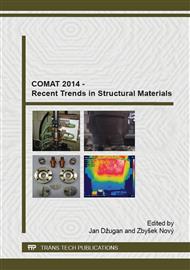p.85
p.91
p.99
p.107
p.113
p.121
p.127
p.135
p.143
Finite-Element Simulation of the Process of Lengthwise Pipe Rolling on a Stub Mandrel
Abstract:
The improvement of the technology of pipe production on a lengthwise rolling mill is proposed. The investigations are carried out on the basis of a lengthwise rolling mill installed at the “Sinarsky Pipe Works” Open Joint-Stock Company. The aim is to master the whole range of production from continuous castings on the existing equipment, as well as to exclude 120 mm diameter rolled workpiece from the production in order to reduce production costs. An increase in the elongation ratio on a lengthwise rolling mill is necessary to master a continuous casting. Rough tube forming on a stub mandrel in a lengthwise rolling mill with rough tube preovalisation has been investigated with the application of the finite-element method. The behavior of the dimensionless parameters characterizing the deformation of the metal in the groove taper as dependent on the rough tube elongation ratio has been determined. The bite begins in the upper part of the groove when the oval rough tube is fed to the lengthwise rolling mill groove. Rough tube preovalisation provides uniform groove filling during lengthwise rolling on a tapered stub mandrel. Besides, it provides a decrease in the intensity of rough tube wall thickening in the groove taper during lengthwise rolling. This enables one to avoid the formation of a “guide mark” defect on the inner surface. The ratio of the longer axis of the rough tube oval cross section to the minor axis must range between 1.15 and 1.25. The rough tube preovalisation before lengthwise rolling provides an opportunity to increase elongation ratio at the lengthwise rolling mill from 1.45 to 2.00. Keywords: A tube rolling-off; a stub mandrel; an automatic mill “tandem”; a finite-element simulation; a coefficient of rough tube ovalisation.
Info:
Periodical:
Pages:
127-133
Citation:
Online since:
October 2015
Price:
Сopyright:
© 2015 Trans Tech Publications Ltd. All Rights Reserved
Share:
Citation:


